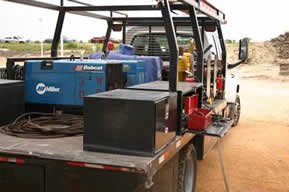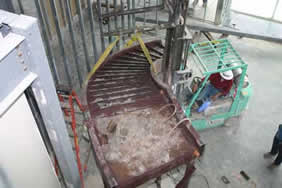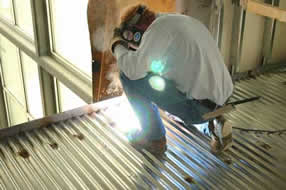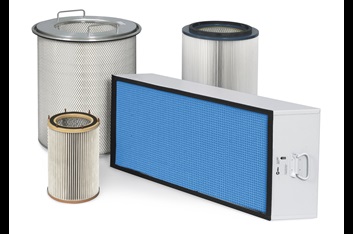Executive Summary
- Strong output enables one operator to Stick weld while others run grinders or other tools.
-
Generator power helps run tools such as a magnetic drill press that could cause safety issues if power fails.
-
Regularly run 200-300 feet of lead with no noticeable decrease in power at the arc.
-
Fully-enclosed case keeps unit protected from jobsite and elements.
-
LP fuel option with running gear provides ultimate portability on hard-to-reach jobsite.
Portable Bobcat Yields Big Results for Hill Country Steel
Structural steel construction company relies on advanced technology and
Miller Bobcat welder/generator for quality, meeting deadlines
 |
Three Bobcats are truck-mounted for mobility. The truck can back up to the front of the building so that the field crew can easily run 150-ft. leads into the mezzanine area.
|
Anyone involved with structural steel knows it’s a cut throat business, but for Hill Country Steel, Converse, Texas, the growing competition isn’t a threat. It’s all about service—and meeting deadlines.
Hill Country’s reputation has grown alongside the booming structural steel business in Texas. However, management knows that they can’t rely on industry trends to ensure company growth. Instead, Hill Country advances its technology to stay in the game. In addition to its computerized sales and estimating programs, Hill Country invested hundreds of thousands of dollars in automated equipment. It also made a smaller—but equally smart—financial investment in Bobcat 250 welding generators from Miller Electric Mfg. Co.
Cutting Out the Competition
Hill Country Steel, with fewer than 50 employees, specializes in commercial structural steel. The company fabricates everything from large warehouses to simple handrails. Approximately 95 percent of its business comes from repeat customers, typically large general contractors in the San Antonio, Houston, Dallas and Austin areas.
Marlo Brown, in charge of purchasing and field operations, believes the company’s success stems, in part, from using advanced technology. Office and shop personnel support the 12-person field team with computerized sales and estimate templates, CAD machines and CNC equipment. This makes Hill Country one of the most advanced structural steel fabricators in San Antonio. In a city where financial success often stems from low technology and inexpensive labor, Hill Country stands out as a state-of-the-art facility.
The company has its own detailing department with six detailers working on CAD machines. The detailers draw out the individual elements that go into fabricating the raw steel, such as where holes are punched in the beams and what to weld on each beam or column. After the drawings are made, the beam goes on a conveyor, through a computerized saw and comes out ready for the fitters to attach the necessary parts. Using a computerized drill line, fabricators can drill about 15 holes per minute, versus one hole per five minutes for laying out each hole and drilling it by hand.
For connecting the beam to a column, holes drilled into the beam are joined with holes in the column using clip angles (an L-shaped piece of metal used for steel connections). A new computer-controlled Pedinghaus Anglematic machine punches all the holes in the angles, primarily for small clip angles. The computerized drill line drills holes in the flange width on beams up to 36 in.
In many cases, the beams have camber in them. Specifically, a cambering machine creates a hump in the beam so that when concrete is poured on floors above, the beam will come back to level and not sag.
In addititon to upgrading its in-shop equipment to improve productivity, Hill Country also upgraded its field equipment. On a job for one large manufacturer of stadium lighting, Hill Country put the Bobcat 250 to the test when fabricating the facility's steel roof structor and extensive mezzanine office space. For such a large project with tight deadlines, the compact, reliable Bobcat helps Hill Country stay on schedule.
“Those Bobcats are normally running 10 hours a day, five to six days a week, with zero downtime,” says Brown. “They’re amazing little machines.”
Zero Downtime
In the field, where buildings are in the preliminary stages of construction, sites typically don’t have permanent power. This presents a problem when a variety of electrical hand tools are needed on site, such as grinders, sanders, Skil® saws and electric band saws. With the Bobcat’s ability to provide 11,500 watts of useable peak power and generator power while welding (see following chart), Brown’s crew can still plug their tools into the Bobcat and Stick weld at the same time without tripping a breaker.
Simultaneous Welding and Power
|
Weld Current (Amps)
|
Total Power (Watts)
|
120V Receptacle (Amps Available)
|
240V Receptacle (Amps available)
|
|
0
|
10,000
|
84*
|
42*
|
|
90
|
8000
|
66*
|
33
|
|
125
|
5200
|
43*
|
21
|
|
180
|
3500
|
29*
|
14
|
|
250
|
2200
|
18
|
9
|
For example, if you’re welding at 125 amps, you also have 5200 watts available for powering lights or tools (either 43 amps from the 120 volt full kVA receptacle or 21 amps from the 240 volt full kVA receptacle).
*50A, 120/240 VAC receptacle. See owner’s manual for additional information.
“When you trip a breaker, you have to climb down off the steel, come back to the machine and try to figure out what tripped,” says Brown. “Then you have to wait for a little while, fire the machine back up and go back to work. It’s a time-consuming affair, but it doesn’t happen with the Bobcat.”
Losing power could also be dangerous. The crew uses a magnetic drill press for drilling into I-beams. While using a magnetic drill base in a gravity-acting position (i.e., for drilling down) doesn’t present a safety issue as it relates to a power outage, drilling overhead can create hazards. “If you lose power, the drill falls, potentially hurting someone below,” says Brian Young, sales representative for 3-D Welding & Industrial Supply, Inc. This is just one of the reasons why Young introduced Hill Country Steel to the new Bobcat.
For fabricating the steel in the mezzanine office space, as well as an elliptical staircase, three truck-mounted Bobcats effectively served Hill Country’s welding and power requirements. “For welding the staircase, we have to make sure that welds are ground smooth to create a polished, seamless appearance,” says supervisor Ralph Ramirez. “I actually have one guy cutting or running a grinder off the 115 V input power, and I’ve got another guy welding. The Bobcat is excellent for this job” (see chart).
Typical Equipment Power Usage
Bobcats will easily start and run the following equipment
|
Equipment
|
Starting Watts
|
Running Watts
|
|
Hand Drill (1/2 inch)
|
600
|
600
|
|
Circular Saw (8-1/4 inch)
|
1,400
|
1,400
|
|
Air Compressor (1-1/2 HP)
|
8,200
|
2,200
|
|
Flood Lights (Vapor)
|
1,250
|
1,000
|
|
Millermatic® 212 MIG Welder (30-210, 230V)
|
6,500
|
6,500
|
|
Spectrum® 626 Plasma Cutter (½-in. cut)
|
6,900
|
6,900
|
The Power to Move
The truck-mounted Bobcats have about 150 ft. of lead on each machine, but even with extra lead, they don’t experience voltage drops. “We’ve run 200, 300 feet of lead with no depreciable decrease in power at the arc,” says Brown. “As long as your leads are kept up and in good repair, you’re not going to have any problems.”
Still, for a recent job involving a massive eight-story hospital, even 300 ft. of lead didn’t help. Hired to help upgrade an old army hospital in San Antonio, Brown sensed a labor nightmare. Each window—914 in all—needed a 3-in. steel tube frame welded around it, tied from the floor to the ceiling, so that 1/2-in. thick protective glass could be placed.
“We couldn’t figure out how we were going to get all our welding leads from floor to floor, not to mention around the massive floor space,” says Brown. “We would have needed to run about 600 ft. of lead, and then roll it up, move it and unroll it each time we moved. The other thing is, we couldn’t figure out how we were going to get gasoline to the machines every day without it being a safety hazard.”
To solve the problem, Hill Country purchased two Bobcat 250s with the Kohler LP engine option, along with running gear. “Wherever we went in that massive building, we were able to take the Bobcats along with us,” says Brown. “There were minimal fumes and the LP engines ran as quiet as the gas engines in the fully enclosed case. These Bobcats reduced labor costs as well. Before my guys would leave the shop in the morning, they would just load up some propane canisters. Without the flexibility of the LP option, that job would have eaten our lunch.”
Reliable Design
Even with the Bobcats mounted on the truck, they take a beating. “We’ve got racks on top of our trucks for carrying materials to the job site,” says Brown. “Our field crews are forever climbing all over those machines, tying down loads and dropping things. The Bobcats get abused, but they’re just sturdy, durable machines.”
To better protect the Bobcat 250’s engine, Miller designed the case to fully enclose the machine. Removable service doors allow quick access on either side of the units for easy engine maintenance. In addition, the Bobcat’s redesigned airflow path allows air to escape through only one exit port on the top of the rear panel. When the unit is truck-mounted, the airflow path to the top of the unit minimizes the chances of airflow being blocked or hot air re-entering the unit—critical in Texas. The Bobcat, with its 104-degree rating, is designed to perform well in the heat.
“It can get up to 100 degrees down here with 100 percent humidity, and we haven’t had any problems,” says Brown. “Also, now that they’re covered, there’s no airborne material or anything that can actually get in there and affect the machine. It’s a much better design.”
“When we change the oil, we don’t even take the machine off the truck,” adds supervisor Jessie Rico. “We maintain them, service them and change the oil right on the truck. It’s much easier.”
Elliptical Stairway
 |
A view of the elliptical staircase from the mezzanine level. The staircase, held up with a lift, is braced by columns.
|
At the lighting manufacturer's job site, Brown and his crew were in no danger of losing money on the job. For fabricating the elliptical staircase, the field crew easily runs leads from the truck-mounted Bobcats into the mezzanine area where the staircase is erected. The pre-assembled stairway is welded to a landing constructed from 1/2-in. plate light gauge steel (ASTM A992). Erectors need to set the landing with columns that hold it up and then connect the stairway to the landing via the stairway’s stringers. Because the stairway has an ellipse, it is more difficult to fit the stairway precisely to the landing. On top of it, a second staircase attaches to another landing on the second floor. That is, two flights of stairs lead to the mezzanine offices.
For welding the staircase (and for most of its heavy steel construction), Hill Country uses E-7018 1/8-in. electrodes. To hold the column up and connect it to the landing, fillet welds are made in three passes. Otherwise, vertical up welds are made in two passes, such as for bracing the columns. The stringers of the stairway are then fitted and welded to the landing.
After erectors are done welding the stairway to the landing, concrete is poured, but the stairway must be ready—and safe. “After we get done jerking it and pulling on it to get it in the proper location, it has to be architecturally acceptable, which means everything must be ground smooth and flush.” says Brown. “It has to look like a classy stairway, but we also have to make sure everything is safe before anybody climbs on it.”
And that’s just the half of it. Then the next stairway comes in, which will be welded to the mezzanine level by another landing. They’ll pour the stair, pour the rest of the mezzanine and be complete on the staircase project.
The mezzanine itself is fabricated with steel decking using a 6022 5/32-in. deck rod. The decking, essentially the mezzanine floor, is connected to W12- by 8-in. beams, which have fish plates that hold them on larger 16-in. beams.
 |
Deck rods are used to fabricate the mezzanine level decking before concrete is poured.
|
Top-notch Service
Service is a top priority at Hill Country, both given and received. “Anybody can sell steel, but what we try to do is sell service,” says Brown. “We’re not always low bidder, but customers know we can get the job done and it’s going to be done on time. In fact we get a lot of requests to bid from a lot of people, but we try to service maybe the 10 or 15 top customers we have, and they are repeat customers. Probably 95 percent of our customers are repeat customers.”
Hill Country practices what it preaches. Hill country has been a customer of 3-D Welding & Industrial Supply, Inc. for approximately 15 years. “Miller puts out a quality product, but they also get quality people to service and sell their equipment,” says Brown. “It’s such a fast-paced, confusing industry that you can’t keep on top of everything. But when I need something, Brian at 3-D Welding has it. I don’t think Miller would have a supplier that’s not top-notch. I couldn’t see it happening.”
 |
Shown, L-R, are Hill Country Steel supervisor Ralph Ramirez; Hill Country Steel supervisor Jessie Rico; Marlo Brown, manager of field operations, Hill Country Steel; Brian Young, sales representative, 3-D Welding & Industrial Supply.
|
As for the Bobcats, they require very little service. “If you perform the recommended maintenance and change the oil, the Bobcat will last for years and years,” says Young. “I think Hill Country Steel probably has the first Bobcat they ever bought back in ’85 or ’86.”
“It’s like microwaves,” says Brown. “What did we do before we had a microwave? I don’t know what we did before we had these little machines.”